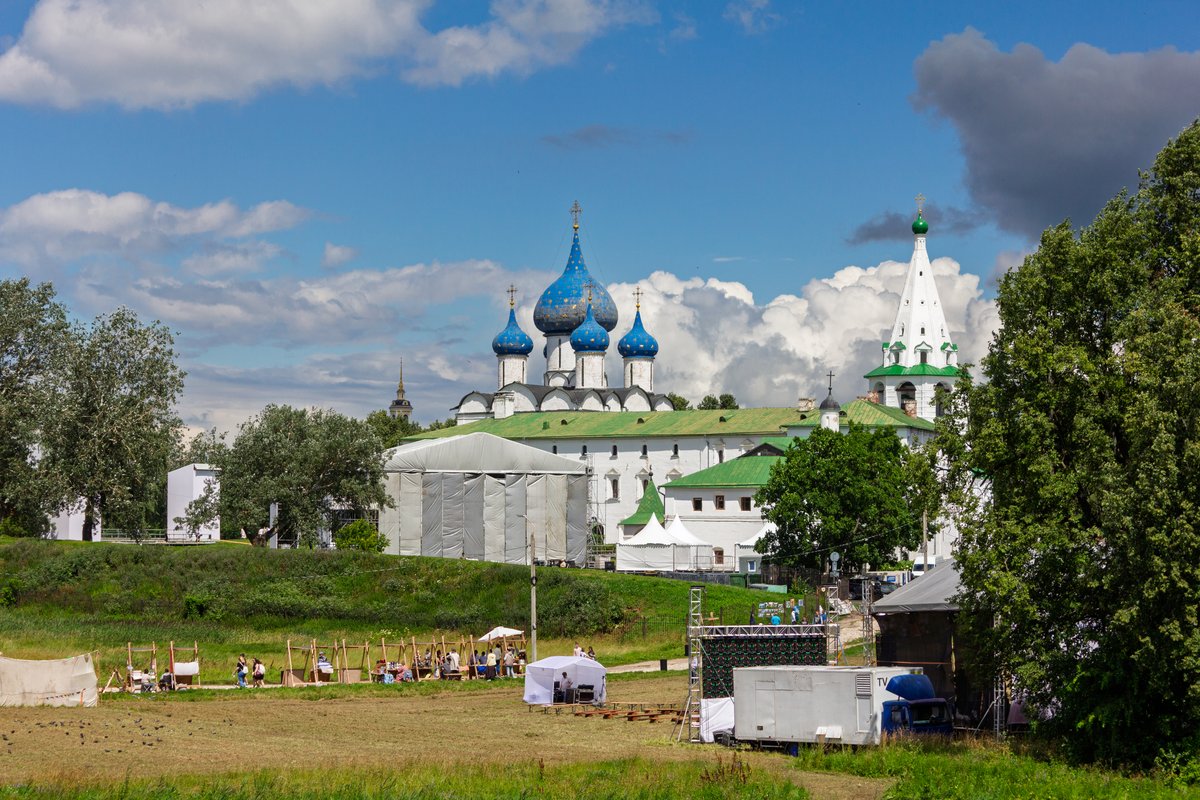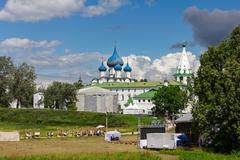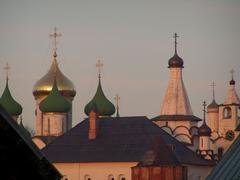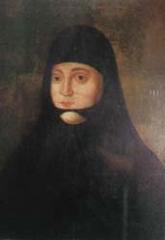
Suzdal Kremlin Visiting Hours, Tickets, and Historical Sites Guide
Date: 14/06/2025
Introduction: The Legacy of Suzdal Kremlin
The Suzdal Kremlin, located in the picturesque town of Suzdal, Russia, stands as a monument to the nation’s medieval heritage and architectural prowess. As the oldest part of Suzdal and a key site on the famed Golden Ring tourist route, the Kremlin showcases centuries of Russian history, religion, and culture. Established in the late 10th or early 11th century along the strategic bend of the Kamenka River, the Kremlin’s ramparts and natural defenses have withstood invasions and witnessed the rise and fall of principalities. Today, the Suzdal Kremlin is a UNESCO World Heritage Site, housing the iconic Cathedral of the Nativity of the Virgin and serving as both a museum and an active place of worship. This guide offers a comprehensive overview of Suzdal Kremlin visiting hours, ticketing, accessibility, historical context, and practical tips to help you plan an unforgettable visit (Adequate Travel, UNESCO, Russia eGuide).
Table of Contents
- Introduction: The Legacy of Suzdal Kremlin
- Early History and Medieval Development
- Architectural Highlights and Key Structures
- Religious and Political Significance
- Cultural Importance and UNESCO Status
- Visitor Information: Hours, Tickets, Accessibility
- Guided Tours, Events, and Travel Tips
- Nearby Attractions in Suzdal
- Preservation Efforts and Modern-Day Importance
- Symbolism and Artistic Influence
- Educational and Research Activities
- Visitor Experience and Practical Advice
- Frequently Asked Questions (FAQ)
- Visual Suggestions and Media Resources
- Conclusion and Final Recommendations
- References
Early History and Medieval Development
The Suzdal Kremlin marks the origin of Suzdal, with fortifications first established in the late 10th or early 11th century. Its location on the Kamenka River offered natural protection, enhanced by earthen ramparts and early wooden palisades. By the 12th century, Suzdal had become an influential political and religious center in the Vladimir-Suzdal Principality. During this period, the Kremlin evolved into the seat of local princes and bishops, and the construction of the Cathedral of the Nativity cemented its role as a spiritual center (Adequate Travel).
Architectural Highlights and Key Structures
Cathedral of the Nativity of the Virgin
At the Kremlin’s heart stands the Cathedral of the Nativity, a masterpiece of early Russian architecture. Originally built in the 1220s and later reconstructed in the 16th century, the cathedral is renowned for its white limestone lower walls, blue domes dotted with golden stars, and exquisite bronze doors from the 13th century. Inside, visitors can admire ancient frescoes spanning from the 13th to the 17th centuries, as well as a five-tier iconostasis (Russia eGuide, Advantour).
Archbishop’s (Bishop’s) Chambers
Adjacent to the cathedral, the Bishop’s Chambers (Palaty) reflect medieval Russian domestic and administrative architecture. Built between the 15th and 18th centuries, these chambers now house museum exhibitions on Suzdal’s religious art, local history, and the life of the Orthodox clergy (Russia eGuide).
Bell Tower
The 17th-century bell tower, constructed from white stone and brick, serves both liturgical and defensive purposes. Visitors can climb to the top for sweeping views of Suzdal and its iconic skyline (wanderlog.com).
Church of St. Nicholas (Nikolskaya)
The wooden Church of St. Nicholas, relocated from Glotovo village, showcases traditional Russian wooden ecclesiastical architecture. Its simplicity contrasts with the grandeur of the stone cathedral and underscores the diversity of religious building traditions in the region (Russia eGuide, russiatrek.org).
Religious and Political Significance
Throughout the Middle Ages, the Suzdal Kremlin was the nerve center for political administration and religious life in northeastern Rus’. Even after Suzdal’s political importance declined in favor of Moscow, the Kremlin remained a vital pilgrimage and religious site. The cathedral survived Mongol invasions and stands as a symbol of resilience and spiritual continuity. Major religious ceremonies, bishop consecrations, and princely events took place within its walls (Adequate Travel).
Cultural Importance and UNESCO Status
The Suzdal Kremlin is part of the “White Monuments of Vladimir and Suzdal,” inscribed as a UNESCO World Heritage Site in 1992. This distinction recognizes its outstanding universal value as a prime example of medieval Russian architecture, urban planning, and cultural evolution. The Kremlin’s harmonious combination of religious, administrative, and defensive structures is celebrated for its authenticity and preservation (UNESCO).
Visitor Information: Hours, Tickets, Accessibility
Suzdal Kremlin Visiting Hours
- General Hours: 10:00 AM – 6:00 PM (April–October); 10:00 AM – 5:00 PM (November–March)
- Closed: Tuesdays and the last Friday of each month (for maintenance)
- Last Admission: 30 minutes before closing
- Note: Hours may change during public holidays or special events—check the official museum website before visiting (Russia eGuide).
Tickets and Admission
- General Admission: 400 RUB
- Reduced Rates: 200 RUB (students, seniors)
- Children under 7: Free
- Combined Tickets: Available for the Kremlin, Museum of Wooden Architecture, and other local sites at discounted package rates
- Purchase: At the entrance or online via the official museum website
Accessibility
- Partial accessibility for visitors with mobility impairments; some historical areas feature uneven terrain or stairs.
- Ramps and assistance are available in certain sections—contact the museum in advance for specific needs.
Guided Tours, Events, and Travel Tips
- Guided tours are offered in Russian year-round, and in English and other languages during peak seasons. Pre-booking is recommended.
- Special events include medieval reenactments, Orthodox festivals, and art exhibitions.
- Getting to Suzdal: Suzdal is about 220 km northeast of Moscow. The closest railway station is in Vladimir, from which buses or taxis connect to Suzdal.
- Getting around: The town’s compact layout makes it easily walkable. Bike rentals, taxis, and horse-drawn carriages are also available.
Nearby Attractions in Suzdal
- Museum of Wooden Architecture and Peasant Life: An open-air museum with historic rural buildings (TravelSetu).
- Monastery of Saint Euthymius: A fortified monastic complex with museums and exhibitions.
- Intercession Convent and Church of Boris and Gleb: Fine examples of Suzdal’s ecclesiastical architecture.
- Kamenka River: Picturesque riverbanks perfect for scenic walks and photography.
Preservation Efforts and Modern-Day Importance
The Kremlin’s preservation is administered by the Vladimir-Suzdal Museum-Reserve, which oversees restoration, conservation, and educational activities. The site’s dual role as a museum and active church ensures it remains a living monument, bridging Russia’s past and present (UNESCO, rbth.com).
Symbolism and Artistic Influence
The cathedral’s blue domes with golden stars symbolize the heavens and the Virgin Mary, a motif echoed throughout Russian Orthodox architecture. The Kremlin’s design and decorative elements have inspired generations of artists, writers, and architects, influencing the development of Russian ecclesiastical and civic buildings (howtorussia.com).
Educational and Research Activities
The Suzdal Kremlin hosts lectures, workshops, and educational programs for children and adults, focusing on heritage preservation and the study of Russian medieval society. Scholars conduct research on the site’s architecture, frescoes, and archaeological remains, contributing to global understanding of Russian history (Russia eGuide).
Visitor Experience and Practical Advice
- Best time to visit: Spring and summer offer pleasant weather and vibrant festivals; winter provides magical snowy landscapes and unique celebrations.
- Photography: Allowed in outdoor areas; restrictions apply inside the cathedral to protect artworks—always check on-site signage.
- Facilities: Visitor center, restrooms, gift shops, and cloakrooms are available near the entrance.
Frequently Asked Questions (FAQ)
Q: What are the Suzdal Kremlin visiting hours?
A: 10:00 AM–6:00 PM (April–October); 10:00 AM–5:00 PM (November–March). Closed on Tuesdays and the last Friday of each month.
Q: How much are tickets?
A: 400 RUB general admission; 200 RUB for students/seniors; children under 7 enter free.
Q: Are guided tours available?
A: Yes, in Russian and other languages during peak season. Book in advance.
Q: Is the Kremlin accessible for visitors with disabilities?
A: Some areas are accessible; contact the museum for details.
Q: What else should I see in Suzdal?
A: Museum of Wooden Architecture, Monastery of Saint Euthymius, and the scenic Kamenka River.
Visual Suggestions and Media Resources
- Use high-quality images with descriptive alt text such as “Suzdal Kremlin Cathedral blue domes” and “Suzdal Kremlin visiting hours.”
- Embed interactive maps showing the Kremlin and nearby attractions.
- Feature virtual tours and official photos from the Vladimir-Suzdal Museum-Reserve.
Conclusion and Final Recommendations
The Suzdal Kremlin is a masterpiece of medieval Russian architecture and culture, offering immersive experiences for visitors of all ages and interests. From its iconic cathedral and ancient ramparts to living traditions and vibrant festivals, the Kremlin invites you to step back in time and connect with the roots of Russian heritage. Prepare for your visit by checking current Suzdal Kremlin visiting hours, ticket prices, and available tours. Don’t forget to explore the surrounding historical sites and engage with local customs for a truly enriching journey.
For up-to-date information, download the Audiala app, follow official social media channels, and consult trusted resources such as Advantour, TravelSetu, and the official Suzdal tourism website.
References
- Adequate Travel
- UNESCO
- Russia eGuide
- RBTH
- How to Russia
- TravelSetu
- Advantour
- RusSpirit
- Expresstorussia
- Wanderlog
- russiatrek.org


